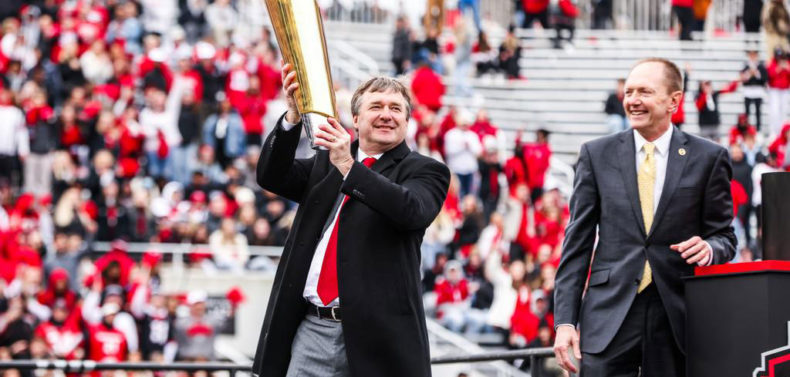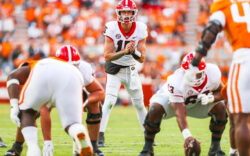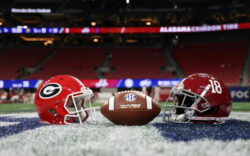I never thought I could love the offseason so much.
I didn’t need to spend the spring and summer months pining for Georgia football and another shot at glory like I had my entire adult life. Instead, I basked in the glory of the Dawgs’ national title. I didn’t miss football, because I felt like I still had it.
My most-watched clip on YouTube in the past seven months has been Kelee Ringo’s pick-six to seal the title. The second most-watched is Stetson Bennett’s bomb to AD Mitchell to take the lead in the fourth quarter. I’ve rewatched the title game in full twice and watched the full season highlights somewhere between five and 10 times. I bought two national championship T-shirts that remind me of the feat whenever I wear them. I wear them a lot.
But while Georgia fans basked in our own glory, college football was busy undergoing rapid change. The ramifications weren’t felt until this offseason, but the process started before the 2021 season began with three foundational changes to the sport: the one-time transfer rule, allowing players to transfer schools without sitting out a season; allowing players to profit from their own name, image and likeness (NIL); and the SEC inviting Texas and Oklahoma to join its ranks.
The change was gradual, at first. We saw more transfers than normal before last season. Players were using NIL to make money shilling chicken fingers and Dr. Pepper. As the season began to draw to a close, while the Dawgs were busy with a national title run, the change went from gradual to sudden. The result is a college football landscape that looks dramatically different than it did even a year ago.
NIL isn’t just for chicken and soda anymore—it’s for recruiting. Down-on-their-luck programs with deep-pocketed boosters have been willing to splash cash on high-schoolers and transfers in a bid to change their fortune. This has created unprecedented player movement in the sport, and the potential for a program to rebuild in a year or two.
So the players are being paid now, but by boosters and businesses, not the schools. This leaves the schools with plenty of money to try to find a coach who can lead them through one of those quick rebuilds. USC, LSU and Miami poached proven coaches from major programs by giving them ungodly gobs of money. In response, coaches who have actually won titles, such as Kirby Smart and Nick Saban, demanded raises because they’re better than those dudes, and got even more ungodly gobs of money.
Further up the ladder, money from ballooning television contracts greased the wheels of conference realignment. The SEC fired the first shot by bringing in Texas and Oklahoma. The Big Ten responded this offseason by bringing USC and UCLA onboard, then signing a multi-billion-dollar media rights deal. We’re moving closer by the day to a college football duopoly ruled by the SEC and Big Ten.
College football as we knew it for our entire lives is over. The season that’s about to begin is College Football 2.0. I can’t say I’m happy about it, although I don’t have the space to explain why—not right now, at least. But I do take some solace in the fact that the Georgia Bulldogs were, in some respects, the last national champions.
But being the final champions of college football’s old world will only keep me so happy for so long. I also want to see the Dawgs stand atop this new world. With other programs having more tools to level the playing field and conference expansion likely bringing with it the end of the divisions and more conference games, the path to the title will only get tougher.
Bringing us to this season, the first of College Football 2.0. And while the sport’s transformation has been rapid, it hasn’t been rapid enough to knock the Dawgs from their spot among college football’s elite. Georgia will be damn good again this season, if different in some ways than last season, and has the ability to challenge for another national title.
There will be plenty of names you know on this team—players you’ll remember for the rest of your life because of their role in the national title season, such as Bennett, Ringo, Brock Bowers, Nolan Smith, Jalen Carter, Sedrick Van Pran-Granger and plenty more. But with a record-setting 15 players from last year’s team taken in the NFL Draft, it’s safe to say you’re going to have to learn some new names as well.
Georgia fielded one of the greatest defenses in college football history last season, so it’s no surprise the defense suffered the bulk of the attrition. Despite those losses, there is more experience there than you might assume. With a 27-point average margin of victory last season, there was plenty of garbage time for young players to earn reps.
The name talked about most coming out of camp is inside linebacker Jamon “Pop” Dumas-Johnson, who has the unenviable task of taking over for fan favorite Nakobe Dean. But Dumas-Johnson seems like he has what it takes to become a fan favorite in his own right. His mother gave him the nickname, but his teammates and coaches swear it’s for the sound made when he lights up an opponent.
Smart singled out true freshman defensive lineman Mykel Williams for praise, something the coach does rarely for freshmen. You can expect big things from him, now or down the line. In the secondary, Kamari Lassiter and Nyland Green are pushing to fill Derion Kendrick’s role at cornerback. Walk-on Dan Jackson will replace Lewis Cine at safety, but true freshmen Malaki Starks and JaCorey Thomas could push him. Zion Logue’s task is to fill Jordan Davis’s enormous shoes at nose tackle.
With the defense likely to experience some growing pains, the offense must be able to win games. Thankfully, Stetson Bennett and offensive coordinator Todd Monken had an entire offseason to prepare Bennett as QB1. There should be more fluency between Bennett and his teammates now that he’s gone a full offseason as “the guy.”
Bennett should also enjoy more continuity amongst his receivers. Jermaine Burton transferred to Alabama, but the rest of the unit remains intact. Look for Dominick Blaylock to re-emerge after ACL injuries over the past two seasons. Sophomores Mitchell and Ladd McConkey should be ready to take the next step in their development.
But the tight ends are the biggest receiving threats. There is Bowers, considered the best tight end in college football; Darnell Washington, who blocks like a tackle and stands a full head taller than any defender who checks him; and now Arik Gilbert, who sat out last season after transferring from LSU. There’s no telling all the funky and fun ways Monken will find deploy them.
Some of the names and faces may be new, but the challenge remains the same. Go 12-0, and it doesn’t matter what happens in the SEC Championship Game. Go 12-0, and you’re in the College Football Playoff. And if you’re in the College Football Playoff, as we’ve seen, anything is possible.
Like what you just read? Support Flagpole by making a donation today. Every dollar you give helps fund our ongoing mission to provide Athens with quality, independent journalism.










